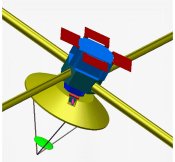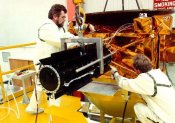The Interstellar Heliopause Probe
Scientific objectives
 |
|
Interface between the Heliosphere and Interstellar Medium (ESA & Lotfi Ben Jaffel, Martin Kornmesser and Lars Lindberg Christensen) |
The main scientific objective of the IHP is to investigate the interface region between the local interstellar medium and the heliosphere and to truly reach the interstellar medium at 200 AU. The scientific questions that the IHP will aim to answer as it travels towards this region are:
- What is the nature of the interstellar medium?
- How does the interstellar medium affect the solar system?
- How does the solar system impact the interstellar medium?
Mission profile
The IHP mission profile requires the spacecraft to travel a distance of 200 AU from the Sun within 25 years. To reach the interstellar medium in the shortest possible time the spacecraft will have to be launched in the direction of the heliosphere nose, which is located at 7.5° latitude and 254.5° longitude, in the ecliptic coordinate frame.
 |
|
IHP Spacecraft |
With solar sails the IHP can meet these requirements by means of a solar sail with a characteristic acceleration of 1.0 mms-2. To obtain the required solar system escape velocity the IHP will perform two close flybys of the Sun (at minimum 0.25 AU). Closer distances would provide even higher escape velocities, however with the current materials selected for the sail design 0.25 AU distance will be the closest possible distance to keep the sail at the required temperatures.
Sample Payload
| Payload | Purpose |
| Plasma Analyser | Elemental and isotopic composition of plasma and the associated energy levels at temporal composition |
| Plasma radio wave experiment | Plasma and radio waves experiment |
| Magnetometer | Magnetic field measurements in very low fields |
| Neutral and charged atom detector | Energy levels, composition, mass, angular and energy distribution of neutral atoms |
| Energetic particle detector | Energy levels of cosmic rays |
| Dust analyser | Energy levels, mass and composition of dust particles |
| UV-photometer | Hydrogen density |
Solar Sail
The preliminary concept for IHP employs a spinning solar sail. The characteristics of the sail can be seen in the table below.
|
Solar Sail Characteristics | |
| Sail Configuration |
Spinning |
| Sail Film |
CP-1 |
| Sail film thickness |
1-2 micron |
| Solar sail system mass |
~310 kg |
| Solar sail assembly loading |
4 gm-2 |
| Solar sail radius |
~150 m |
Mass Budget
The current mass budget for IHP is given in the table below.
| Sample Mass Budget | |
| IHP Spacecraft Dry Mass |
210 kg |
| Solar Sail System Mass |
310 kg |
| System margin (20 %) |
104 kg |
| Total launch mass |
624 kg |
Technological Challenges
The IHP Technology Reference Study is intended to identify the technologies required for a mission to the interstellar Heliopause and beyond. The main technologies requiring development are outlined below:
Potential solar sail deployment concept
Solar Sail Deployment: Solar sails require structures that are extremely large and a safe deployment mechanism needs to be developed. For the IHP the sail area is in excess of 50 000 m2, which will be very challenging to deploy without causing ruptures, damaging coatings, etc.

Solar Sail Material: The sail material will have to withstand a solar flux of approximately 16 times the flux at Earth. During its required 5 year lifetime it is important that the sail keep its optical properties, as the performance of the sail is directly dependent on the reflectivity of the coating.
Lightweight Booms: The current study baseline is utilizing lightweight booms to provide rigidity to the structure. These booms have a specific mass in excess of 100 g/m and are longer than 120 m. Further development of lighter booms would greatly benefit the IHP.
Solar Sail Phase Attitude Determination and Control: There are several options for performing attitude control. The options currently under consideration include a gimbaled boom between the sail and spacecraft, moving masses along the boom structure, and tip vanes or thrusters on the booms.
Solar Sail Jettison Mechanism: A low mass jettison mechanism is required that can safely jettison the sail from the spacecraft after 5 years of sailing with a minimum risk of collision between the extended sail structure and the spacecraft.
Ulysses Radioisotope Thermal Generator (Image credit: NASA)
Power: Beyond the orbit of Jupiter the use of solar energy is very inefficient due to the low solar flux. The only real alternative for power generation is the use of nuclear energy. IHP and similar large distance, long duration missions (e.g. missions to the outer planets) require European technology developments for radioisotope power generation and, in particular, in the field of thermal to electrical energy conversion.

Communication: The communication system for IHP will be limited to an average downlink data rate of around 200 bps at 200 AU. Currently RF and optical communication are being considered. For the optical communication issues like the acquisition strategy, lightweight components and laser lifetime must be solved. For an RF system development of lightweight antennas and highly efficient travelling wave tube amplifiers are required.
Lifetime and Autonomy: The design lifetime of the IHP must be more than 25 years. The consequences to all subsystems, components and materials must be evaluated in detail and specific test procedures must be developed.
Study details
This study was completed in 2006. It was performed by SRE-PAP with the assistance of the Kayser-Thede, Surrey Space Center, University of Glasgow and Cosine Research.
Contact Information
For further information about this study please contact the study manager:
Dr. Peter Falkner
Head of Planetary and Solar System Exploration Studies Section (SRE-PAP)
Advanced Studies and Technology Preparation Division (SRE-PA)
European Space Agency, ESA-ESTEC
Postbus 299, NL-2200 AG Noordwijk, The Netherlands
tel: +31 71 565 5363
e-mail: Peter. Falkner esa.int
esa.int
